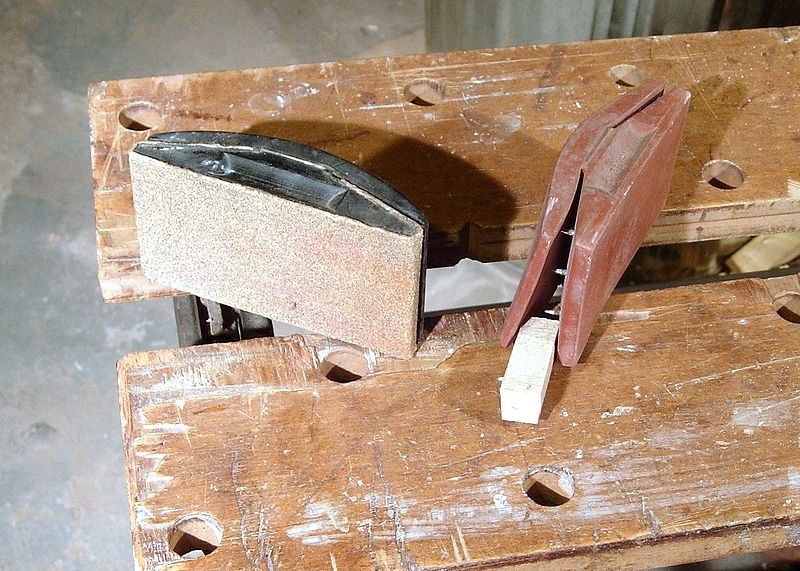Sanding
Contents |
[edit] Introduction
Sanding is the act of using abrasive papers either to smooth or remove layers from certain types of surfaces (such as furniture, walls, ceilings, doors, floors and so on) or to roughen surfaces so other materials are able to adhere to them more effectively.
For large or commercial projects, sanding is often undertaken using electrical tools. There are also a number of manually-operated handheld sanders (suitable for small woodworking projects) such as sanding blocks, much larger machines for sanding large areas such as floors and even devices that can be attached to electric drills so they can be adapted for sanding purposes.
Sandpaper is typically available in different shapes for different applications, including:
- Sheet.
- Belt.
- Fitted shapes such as disks, triangles, rectangles and so on for specific tools.
- Rolls (also referred to as shag rolls).
- Sponges (for tight places).
Steel wool can also be used for some types of sanding.
[edit] Types of abrasive papers
The most common types of abrasive papers are made from five different kinds of materials known as grit. Four of these types of grit are stuck to the sanding sheets with glue. If the grit is spaced across the sheet, it is referred to as open coat; closed coat is the term used to describe paper that has been completely covered by grit. Closed coat tends to clog (or choke) more quickly than open coat.
The five materials include:
- Glass (closed). Glasspaper produces a very smooth surface and tends to wear out quickly.
- Garnet (open). Garnet paper is red in colour and harder than glass; however, it still tends to wear quickly.
- Aluminium oxide (open). This artificial abrasive paper is hard wearing and long lasting. It is typically used for machines rather than manual sanding purposes.
- Silicon carbide (open). Another artificial abrasive, silicon carbide applied to waterproof paper can make it suitable for wet or dry applications. When moistened with water, white spirit or other liquids, these abrasive papers are used to rub down resin varnishes or cellulose paints.
- Tungsten carbide (open). Grains of tungsten carbide are nearly as hard as diamonds and produce extremely durable abrasive papers that can be cleaned.
Sandpaper is available in different grades: coarse, medium and fine.
[edit] Sandpaper standard
ISO 6344 is a three part standard that covers coated abrasives. It includes:
- ISO 6344-1:1998 Coated Abrasives - Grain Size Analysis - Part one: Grain size distribution test.
- ISO 6344-2:1998 Coated Abrasives - Grain Size Analysis - Part Two: Determination of grain size distribtution of macrogrits P12 to P220.
- ISO 6344-3:2013 Coated Abrasives - Grain Size Analysis - Part Three: Determination of grain size distribution of microgrits P240 to P2500.
[edit] Related articles on Designing Buildings Wiki
- Ash or Oak wood flooring.
- Bamboo flooring.
- Carpentry.
- Construction dust.
- How to keep dust under control during a home renovation.
[edit] External resources
- BSI, ISO 6344-1:1998 Coated Abrasives - Grain Size Analysis - Part one: Grain size distribution test.
- BSI, ISO 6344-2:1998 Coated Abrasives - Grain Size Analysis - Part Two: Determination of grain size distribtution of macrogrits P12 to P220.
- BSI, ISO 6344-3:2013 Coated Abrasives - Grain Size Analysis - Part Three: Determination of grain size distribution of microgrits P240 to P2500.
Featured articles and news
One of the most impressive Victorian architects. Book review.
RTPI leader to become new CIOB Chief Executive Officer
Dr Victoria Hills MRTPI, FICE to take over after Caroline Gumble’s departure.
Social and affordable housing, a long term plan for delivery
The “Delivering a Decade of Renewal for Social and Affordable Housing” strategy sets out future path.
A change to adoptive architecture
Effects of global weather warming on architectural detailing, material choice and human interaction.
The proposed publicly owned and backed subsidiary of Homes England, to facilitate new homes.
How big is the problem and what can we do to mitigate the effects?
Overheating guidance and tools for building designers
A number of cool guides to help with the heat.
The UK's Modern Industrial Strategy: A 10 year plan
Previous consultation criticism, current key elements and general support with some persisting reservations.
Building Safety Regulator reforms
New roles, new staff and a new fast track service pave the way for a single construction regulator.
Architectural Technologist CPDs and Communications
CIAT CPD… and how you can do it!
Cooling centres and cool spaces
Managing extreme heat in cities by directing the public to places for heat stress relief and water sources.
Winter gardens: A brief history and warm variations
Extending the season with glass in different forms and terms.
Restoring Great Yarmouth's Winter Gardens
Transforming one of the least sustainable constructions imaginable.
Construction Skills Mission Board launch sector drive
Newly formed government and industry collaboration set strategy for recruiting an additional 100,000 construction workers a year.
New Architects Code comes into effect in September 2025
ARB Architects Code of Conduct and Practice available with ongoing consultation regarding guidance.
Welsh Skills Body (Medr) launches ambitious plan
The new skills body brings together funding and regulation of tertiary education and research for the devolved nation.
Paul Gandy FCIOB announced as next CIOB President
Former Tilbury Douglas CEO takes helm.























